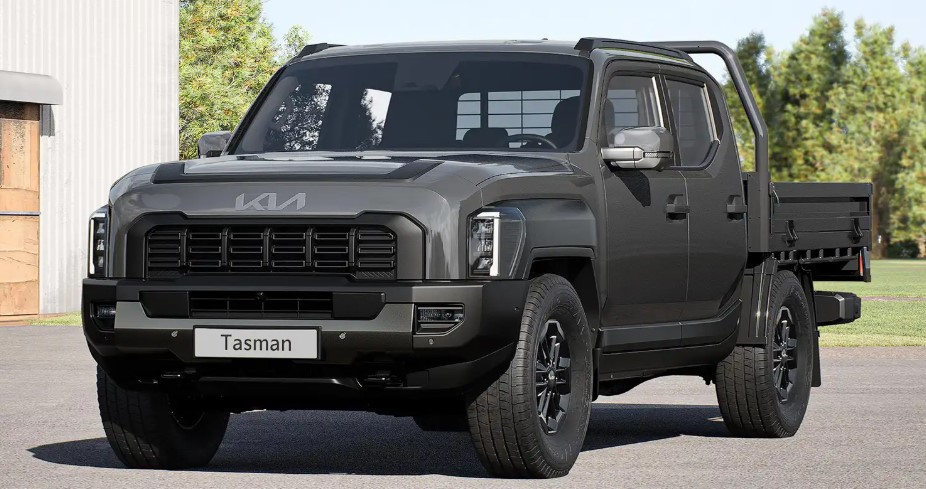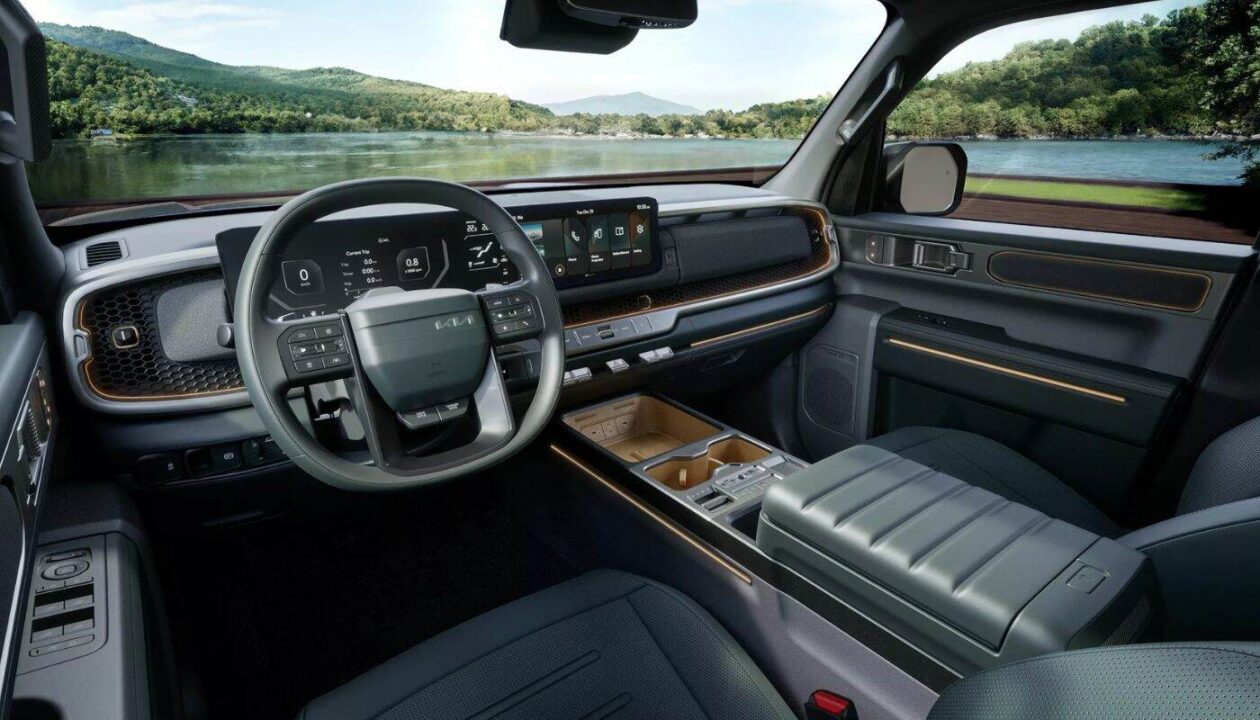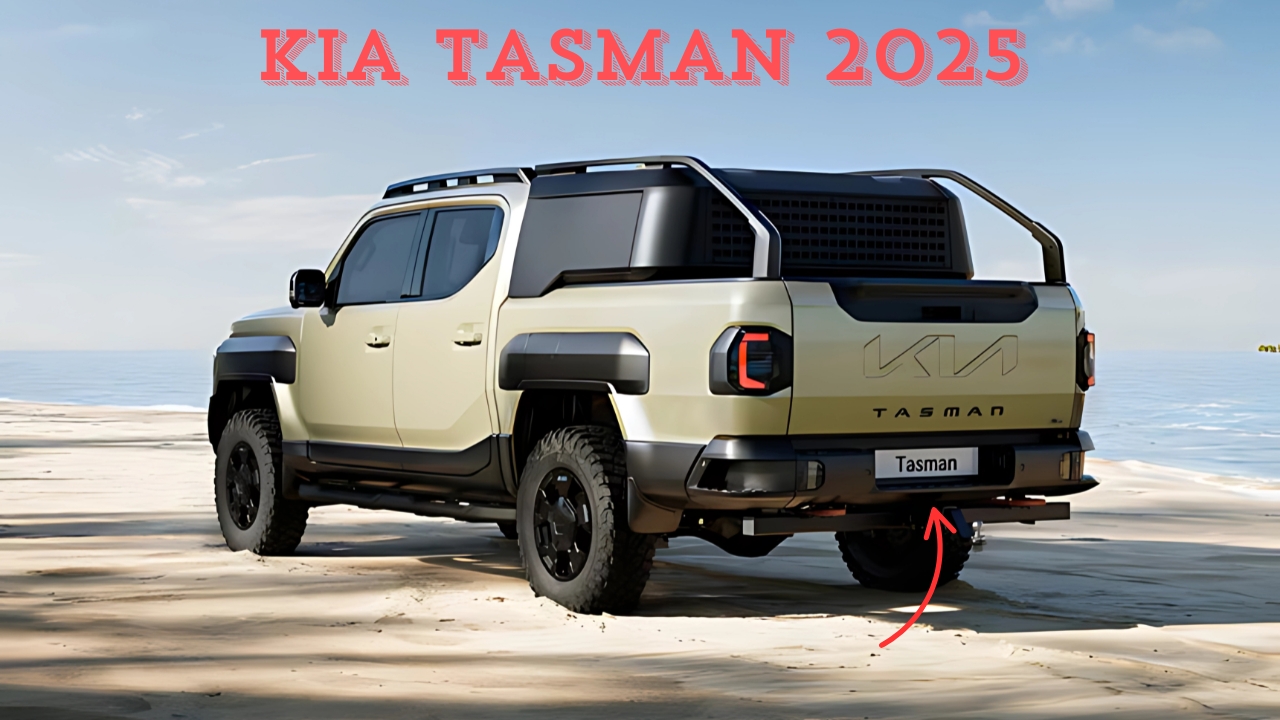The 2025 Kia Tasman marks Kia’s bold entry into the fiercely competitive midsize pickup truck market, challenging industry giants like the Ford Ranger and Toyota HiLux.
With its rugged design, advanced technology, and a price point that undercuts many rivals, the Tasman is poised to make waves in Australia, South Korea, the Middle East, and beyond. But what sets this pickup apart? Beyond its eye-catching (and polarizing) exterior, the Tasman offers a compelling blend of affordability, fuel efficiency, and practical features tailored for both work and adventure.
In this article, we’ll dive into the details of the 2025 Kia Tasman, exploring its pricing, mileage, specifications, and why it’s generating so much buzz.
A New Contender in the Pickup Market
Kia has long been a household name for reliable SUVs and sedans, but the Tasman is its first foray into the pickup truck segment. Unveiled in October 2024 at the Jeddah International Motor Show and in Hobart, Tasmania, the Tasman is a body-on-frame truck designed to tackle tough terrains while offering a premium cabin experience.
Named after the Tasman Sea between Australia and New Zealand, this truck reflects Kia’s focus on these key markets, with significant input from Kia Australia during its four-year development process.
The Tasman isn’t just another ute—it’s a carefully crafted vehicle aiming to disrupt the status quo. With a starting price of AUD $42,990 in Australia (plus on-road costs), it undercuts competitors like the Ford Ranger XL 4×2, making it an attractive option for budget-conscious buyers. But affordability doesn’t mean cutting corners.
The Tasman boasts modern tech, robust off-road capabilities, and fuel efficiency that makes it a practical choice for both tradies and weekend adventurers.
Pricing: Competitive and Accessible

One of the Tasman’s biggest draws is its competitive pricing. In Australia, where the ute market is dominated by the Ford Ranger and Toyota HiLux, Kia has positioned the Tasman to offer value without sacrificing quality. Here’s a breakdown of the pricing for the dual-cab pickup models, as per Kia Australia’s announcements:
| Variant | Drivetrain | Price (AUD, ex. on-road costs) |
|---|---|---|
| S | 4×2 | $42,990 |
| S | 4×4 | $49,990 |
| SX | 4×4 | $54,490 |
| SX+ | 4×4 | $62,390 |
| X-Line | 4×4 | $67,990 |
| X-Pro | 4×4 | $74,990 |
In markets like the UAE, the Tasman starts at AED 118,290 (approximately $32,200 USD), with the top-spec X-Pro reaching AED 178,000 ($48,400 USD). For comparison, in India, where the Tasman is yet to be confirmed, estimates suggest a starting price of around ₹37.03 lakh (approximately $44,000 USD).
These figures position the Tasman as a value-driven option compared to pricier rivals like the Toyota HiLux or Nissan Navara.
Kia also offers novated lease-compatible variants with payloads under 1,000 kg, catering to buyers seeking tax benefits. Single-cab and cab-chassis models are slated for release later in 2025, with pricing to be announced closer to their launch.
This tiered pricing strategy ensures the Tasman appeals to a wide range of buyers, from budget-conscious tradies to those seeking a premium off-road experience.
Mileage: Efficiency for the Long Haul
Fuel efficiency is a critical factor for pickup trucks, especially for buyers who use their vehicles for long commutes or heavy-duty tasks. The 2025 Kia Tasman is powered by a 2.2-liter turbo-diesel four-cylinder engine in most markets, delivering 154 kW (207 hp) and 441 Nm of torque.
This engine, also found in Kia’s Sorento and Carnival, is paired with an eight-speed automatic transmission (or a six-speed manual in some regions), offering a balance of power and efficiency.
While official fuel economy figures vary by market, early estimates for the diesel Tasman suggest impressive mileage. In India, for instance, the 2.2-liter diesel is expected to achieve 10–12 km/L (23.5–28.2 mpg) in city driving and up to 15 km/L (35.3 mpg) on highways.
These numbers are competitive with other diesel-powered utes like the Isuzu D-Max and Toyota HiLux. For comparison, the petrol variant—a 2.5-liter turbocharged four-cylinder producing 281 hp and 421 Nm—offers slightly lower efficiency, estimated at 8–10 km/L in city conditions and up to 12 km/L on highways.
The Tasman’s efficiency is enhanced by its part-time four-wheel-drive system, which allows drivers to switch to rear-wheel drive for better fuel economy on paved roads.
Features like Eco, Smart, and Sport driving modes, along with terrain-specific settings (Snow, Sand, Mud, and Rock for the X-Pro), optimize performance and fuel consumption based on conditions.
For buyers in regions like the UAE, where desert driving is common, the Tasman’s 800 mm water-wading depth and high ground clearance (up to 252 mm on the X-Pro) ensure it can handle tough terrains without guzzling fuel.
Specifications: Built for Work and Play

The Tasman’s specs make it a versatile contender in the midsize pickup segment. Built on a dedicated body-on-frame chassis, it features independent front suspension and a live rear axle with leaf springs, a setup that balances off-road capability with payload capacity. Here’s a closer look at its key specifications:
- Engines:
- 2.2L turbo-diesel (154 kW, 441 Nm)
- 2.5L turbo-petrol (281 hp, 421 Nm, select markets)
- Transmission: 8-speed automatic or 6-speed manual
- Drivetrain: 4×2 (rear-wheel drive) or 4×4 (part-time all-wheel drive)
- Towing Capacity: 3,500 kg (braked)
- Payload: Up to 1,195 kg (2WD), 1,013 kg (X-Pro 4×4)
- Gross Vehicle Mass (GVM): 3,250 kg
- Gross Combination Mass (GCM): 6,200 kg
- Load Bed Dimensions: 1,512 mm (L) x 1,572 mm (W) x 540 mm (H), 1,173 L capacity
- Ground Clearance: 224 mm (standard), 252 mm (X-Pro)
The Tasman’s load bed is designed with practicality in mind, accommodating Aussie or Euro pallets and featuring corner steps, a 240V power socket, and optional sliding cargo floors. Safety features are robust, including Level 2 ADAS with adaptive cruise control, lane-keep assist, blind-spot monitoring, and a 360-degree camera.
The X-Pro trim adds off-road goodies like a locking rear differential and all-terrain tires, making it a favorite for adventure enthusiasts.
Interior: Premium Comfort Meets Utility
Step inside the Tasman, and you’ll find a cabin that rivals SUVs in comfort and tech. The triple-screen setup—comprising a 12.3-inch digital instrument cluster, a 5-inch HVAC display, and a 12.3-inch infotainment touchscreen—creates a modern, user-friendly interface.
Wireless Apple CarPlay, Android Auto, dual wireless charging pads, and an optional Harman Kardon sound system elevate the experience. The X-Pro even offers a sunroof and heated rear seats, features not commonly found in this segment.
The interior uses sustainable materials like recycled PET fabric and bio-PU synthetic leather, appealing to eco-conscious buyers. A folding center console doubles as a mobile workbench, and the rear seats recline up to 30° for added comfort.
With 940 mm of rear legroom and a 33-liter hidden storage compartment, the Tasman balances practicality with luxury.
Driving Impressions: A Solid Start
Early reviews of pre-production Tasman models, particularly the X-Pro, highlight its off-road prowess. Test drives on Australian gravel roads reveal a firm but confident ride, with the 2.2-liter diesel engine pulling strongly despite slightly lower torque (441 Nm) compared to rivals like the Ford Ranger (600 Nm for V6 models).
The eight-speed automatic transmission is smooth, though some testers noted occasional delays in downshifting during steep climbs. The part-time 4×4 system and terrain modes make it adept at handling mud, sand, and rocky trails, while the high ground clearance and 800 mm wading depth ensure it’s ready for serious off-roading.
On-road performance is still under evaluation, but the Tasman’s independent front suspension and refined cabin suggest it will offer a comfortable ride for daily driving. Kia’s decision to skip AdBlue in Australia, thanks to less stringent emissions standards, simplifies maintenance and reduces running costs.
Market Outlook and Challenges
Kia aims to capture 10% of Australia’s ute market, targeting 20,000 annual sales. This ambition pits the Tasman against established players with loyal followings. While its pricing and features are competitive, the Tasman’s polarizing exterior design—described as “blocky” or “cross-eyed” by some critics—may divide opinions.
However, Kia’s rigorous testing (over 18,000 quality checks) and a 7-year, unlimited-kilometer warranty provide confidence in its reliability.
The Tasman’s lack of a V6 engine or hybrid option at launch may limit its appeal against rivals like the Ranger Raptor. However, Kia has hinted at an electric Tasman by 2026, which could shake up the market further. For now, the diesel-powered Tasman offers a compelling mix of value, efficiency, and capability.
FAQs
What is the starting price of the 2025 Kia Tasman?
The Tasman starts at AUD $42,990 (plus on-road costs) for the 4×2 S variant in Australia.
What is the fuel efficiency of the Kia Tasman?
The 2.2L diesel model is estimated to achieve 10–12 km/L in city driving and up to 15 km/L on highways.
Is the Kia Tasman available in the U.S.?
No, Kia has confirmed the Tasman will not be sold in the U.S., Canada, or Mexico due to import tariffs.
What is the towing capacity of the Kia Tasman?
The Tasman can tow up to 3,500 kg (braked) and carry a payload of up to 1,195 kg.
ALSO READA: Two Hidden Features of the Mitsubishi Triton That Australians Still Don’t Know

